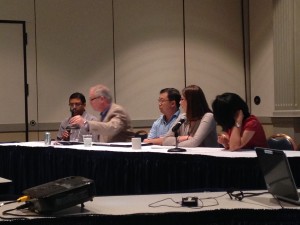The Center for Dielectrics and Piezoelectrics (CDP) held its semi-annual meeting June 18-19, 2015 in State College, PA, with over ninety attendees from industry and universities. The technical agenda focused on current and future needs of dielectrics for advanced energy applications. Geraldo Nojima, Eaton Corporation, presented an overview in which he discussed the demand for new capacitive and insulating materials that can withstand the higher operating temperatures and voltages associated with wide-bandgap power electronics. Wide-bandgap electronics, such as those based on SiC, are critical for numerous advanced energy applications (see http://energy.gov/eere/amo/power-america). These electronics are also being developed for commercialization in the US Department of Energy PowerAmerica program, a Next Generation Power Electronics Manufacturing Innovation Institute lead by North Carolina State University.
While numerous materials innovations are needed for specific applications, advanced polymer dielectrics will enable many advanced energy systems. CDP faculty members Mike Lanagan, Professor of Engineering Science and Mechanics, and Zoubeida Ounaies, Professor of Mechanical Engineering, organized a polymer-focused session to highlight ongoing CDP research by faculty and students that aims to advance state-of-the-art polymer dielectric materials. Following this polymer-focused session, Zoubeida Ounaies led a panel discussion entitled, “Important Challenges and Future Directions in Polymers for Energy Storage and/or Sensing Actuation.” The panel was comprised of representatives from five member companies, including Sandia National Laboratory, 3M, Army Research Lab, Eaton Co., and PolyK. The panel discussion began with each of the five panelists discussing applications and emerging areas for polymer-related active research within their company. Guided by audience inquiries and discussions, panelists also provided multiple perspectives on the issue of breakdown in polymers, and how materials defects and intrinsic contributions contribute to breakdown. The panelists also discussed the role of modeling in designing high voltage breakdown polymers and discovery of new organic materials that push the temperature and voltage performance of polymer capacitors.

